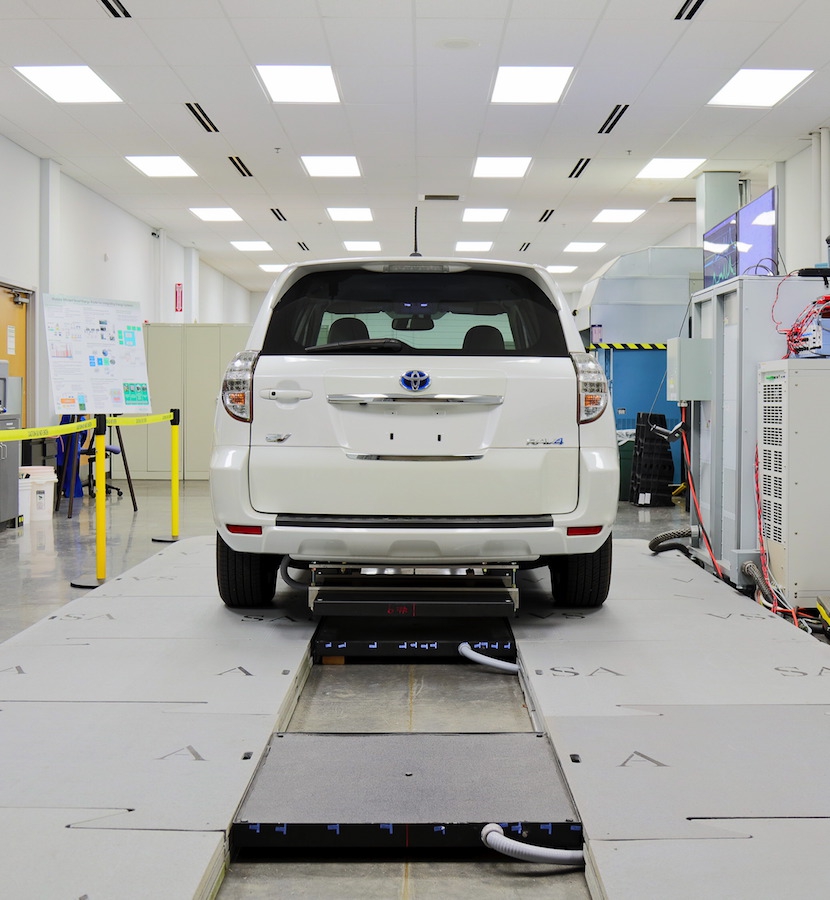
Electrified Transport
Features
Articles
90% efficient 20kW wireless EV charging from ORNL
April 1, 2016 | By Anthony Capkun
 ORNL’s 20kW wireless charging system boasts 90% efficiency. Photo courtesy ORNL.
ORNL’s 20kW wireless charging system boasts 90% efficiency. Photo courtesy ORNL. March 31, 2016 – According to researchers, a “world’s first” 20kW wireless electric vehicle charging system demonstrated at Oak Ridge National Laboratory has achieved 90% efficiency at 3X the rate of the plug-in systems commonly used for electric vehicles today.
“We have made tremendous progress from the lab proof-of-concept experiments a few years ago,” said Madhu Chinthavali, ORNL Power Electronics Team lead. “We have set a path forward that started with solid engineering, design, scale-up and integration into several Toyota vehicles. We now have a technology that is moving closer to being ready for the market.”
This charging ability can help accelerate the adoption and convenience of EVs, says ORNL.
ORNL’s Power Electronics Team achieved this milestone for passenger cars by developing an architecture that included an ORNL-built inverter, isolation transformer, vehicle-side electronics and coupling technologies in less than three years. For the demonstration, researchers integrated the single-converter system into an electric Toyota RAV4 equipped with an additional 10kWh battery.
The researchers say they are already looking ahead to their next target—50kW wireless charging—which would match the power levels of commercially available plug-in quick chargers. Providing the same speed with the convenience of wireless charging could increase consumer acceptance of EVs, they say, and is considered a key enabler for hands-free, autonomous vehicles. Higher power levels are also essential for powering larger vehicles, such as trucks and buses.
As they advance their system to higher power levels, researchers say one of their chief considerations is safety.
“The high-frequency magnetic fields employed in power transfer across a large air gap are focused and shielded,” Chinthavali said. “This means that magnetic fringe fields decrease rapidly to levels well below limits set by international standards, including inside the vehicle, to ensure personal safety.”
Convenience and simplicity are at the heart of the ORNL system, which places a strong emphasis on radio communications in the power regulation feedback channel augmented by software control algorithms. The result is minimization of vehicle on-board complexity as ORNL and partners pursue the long-range goal of connected vehicles, wireless communications and in-motion charging. While the team’s initial focus has been static (motionless) wireless charging, the researchers also evaluated and demonstrated the system’s dynamic charging capabilities.
“Wireless power transfer is a paradigm shift in electric vehicle charging that offers the consumer an autonomous, safe, efficient and convenient option to plug-in charging,” said David Smith, vehicle systems program manager. “The technology demonstrated today is a stepping stone toward electrified roadways where vehicles could charge on the go.”
Industry partners from Toyota, Cisco Systems, Evatran and Clemson University International Center for Automotive Research contributed to the technology development demonstrated today at ORNL. Toyota provided several vehicles for the research, including RAV4s, a Scion and a plug-in Prius.
PHOTO: ORNL’s 20kW wireless charging system boasts 90% efficiency. Photo courtesy ORNL.
Print this page